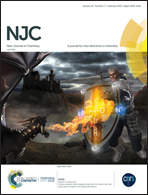Zinc(ii)–organic framework as a multi-responsive photoluminescence sensor for efficient and recyclable detection of pesticide 2,6-dichloro-4-nitroaniline, Fe(iii) and Cr(vi)†
Abstract
A 2D zinc(II) metal–organic framework (Zn-MOF-1) formulated as [Zn2(L)2(TPA)]·2H2O, (L = 4-(tetrazol-5-yl)phenyl-4,2′:6′,4′′-terpyridine, TPA = terephthalic acid) was successfully obtained under solvothermal conditions. Zn-MOF-1 shows a new 2D double-layered honeycomb structure containing Zn2+ ions, ligand L and TPA, with uncoordinated nitrogen atoms (from pyridine rings and tetrazol rings) of L and uncoordinated carboxylate oxygen atoms of TPA, which easily form hydrogen bonds with analytes. Fluorescence analysis reveals that Zn-MOF-1 generates strong blue luminescence, which can be assigned to ligand-centered emission. More importantly, it is the first reported recyclable multi-responsive Zn-MOF fluorescence sensor for pesticide 2,6-dichloro-4-nitroaniline, Fe(III) and Cr(VI) (CrO42−/Cr2O72− ions) detection with high sensitivity, selectivity and low detection limit in methanol or water via fluorescence quenching. Furthermore, selective sensing by Zn-MOF-1 of 2,6-dichloro-4-nitroaniline, Fe3+ ions, and CrO42− or Cr2O72− ions can mainly be attributed to the absorption by the analytes of the excitation and/or emission light of Zn-MOF-1 and the electronic interactions between Zn-MOF-1 and the analytes.



 Please wait while we load your content...
Please wait while we load your content...